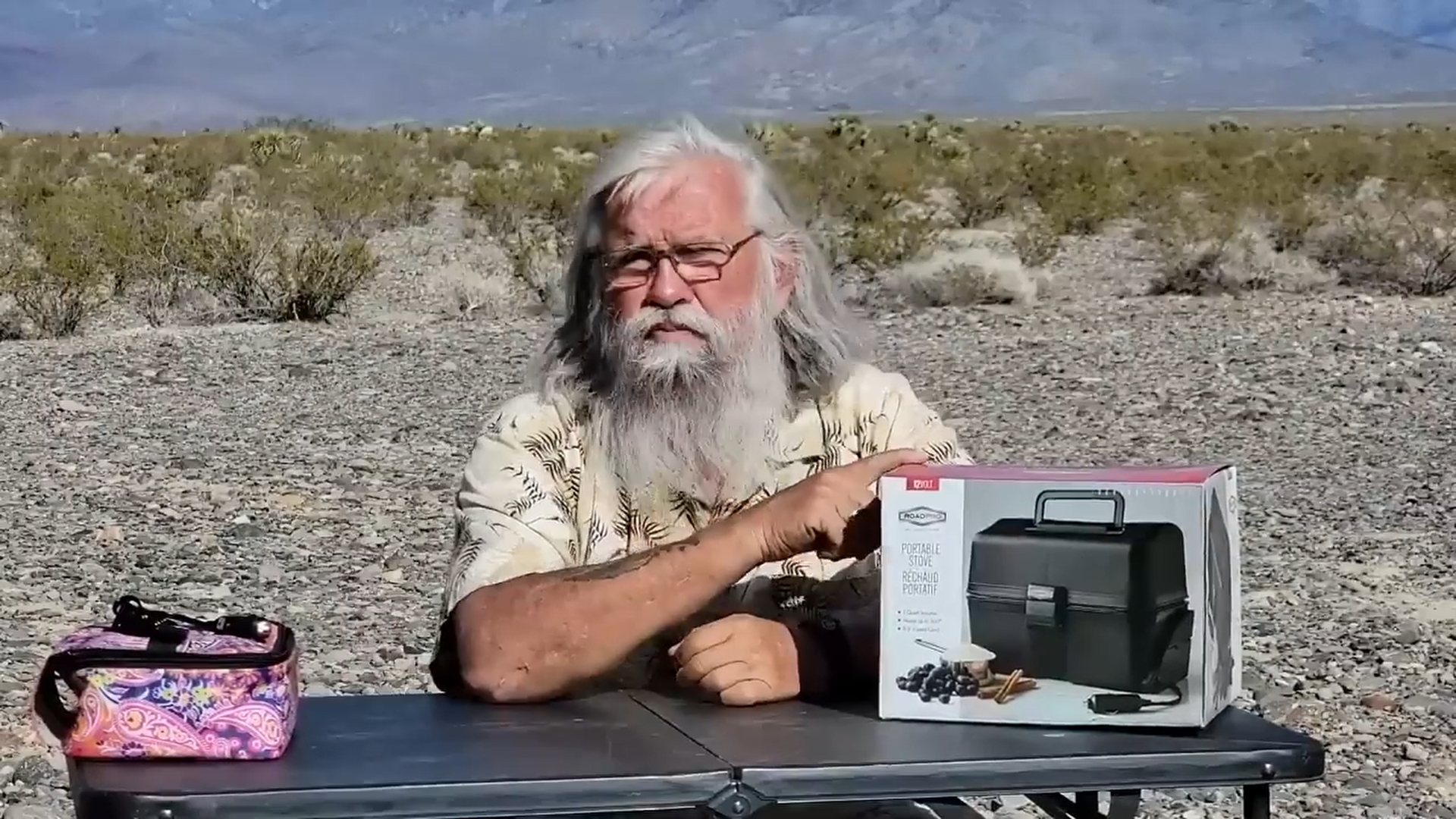
PEOPLE WANT TO use electric cooking. They don’t want propane in their rig because of the smell, safety risks, and so on. So, generally, the answer is no electric cooking. I am running a microwave, and you can, but it’s much more specialized and more expensive. An excellent tool for cooking in your van is the Instant Pot. You’re going to need a minimum of 200 watts of solar. I know people with 200 watts of solar and use the instant pot, but it’s a fairly elaborate form of cooking. It usually makes a pretty big meal. If you’re looking for something quick and fast, the Instant Pot really isn’t a quickie fast thing to put together.
Something that I’ve used over the years and really love is the RoadPro, or what I call the lunch box oven. It is a 12-volt item, and it’s not quick. It will take thirty to forty-five minutes, but it’s a fairly low power draw. I really like it. If you don’t want to use a propane or a butane stove, the RoadPro oven may be all many of you need.
I have a friend who’s been using this HotLogic. If you look inside, it comes with a little plastic dish to use, and basically, it is just a 12-volt hot plate. My friend hasn’t been very happy with it, it’s too slow. You don’t need this to be instant, but she says it takes hours to cook something. If you’re cooking meat or anything from scratch, you’re looking at a substantial amount of time in both of these.
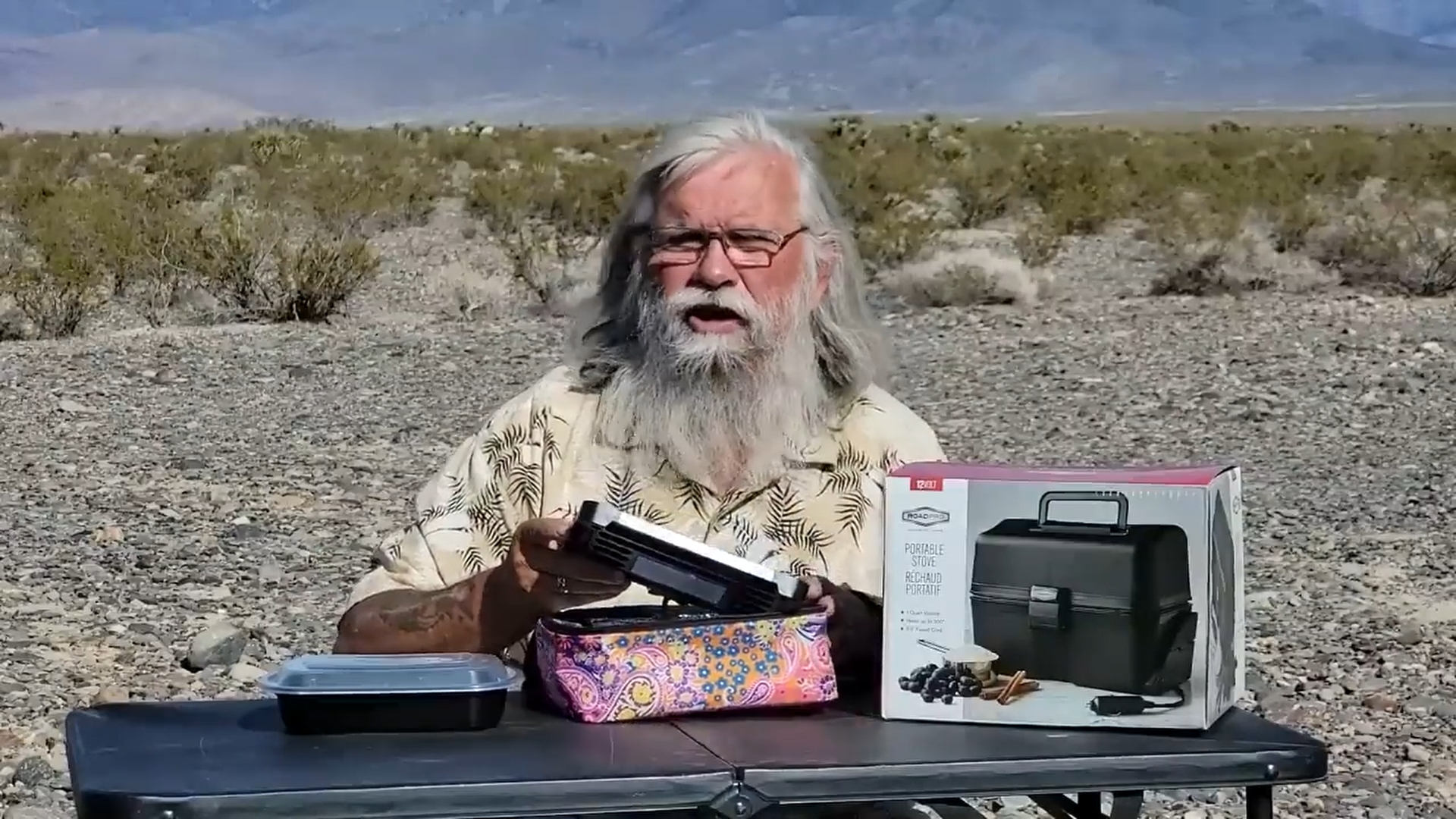
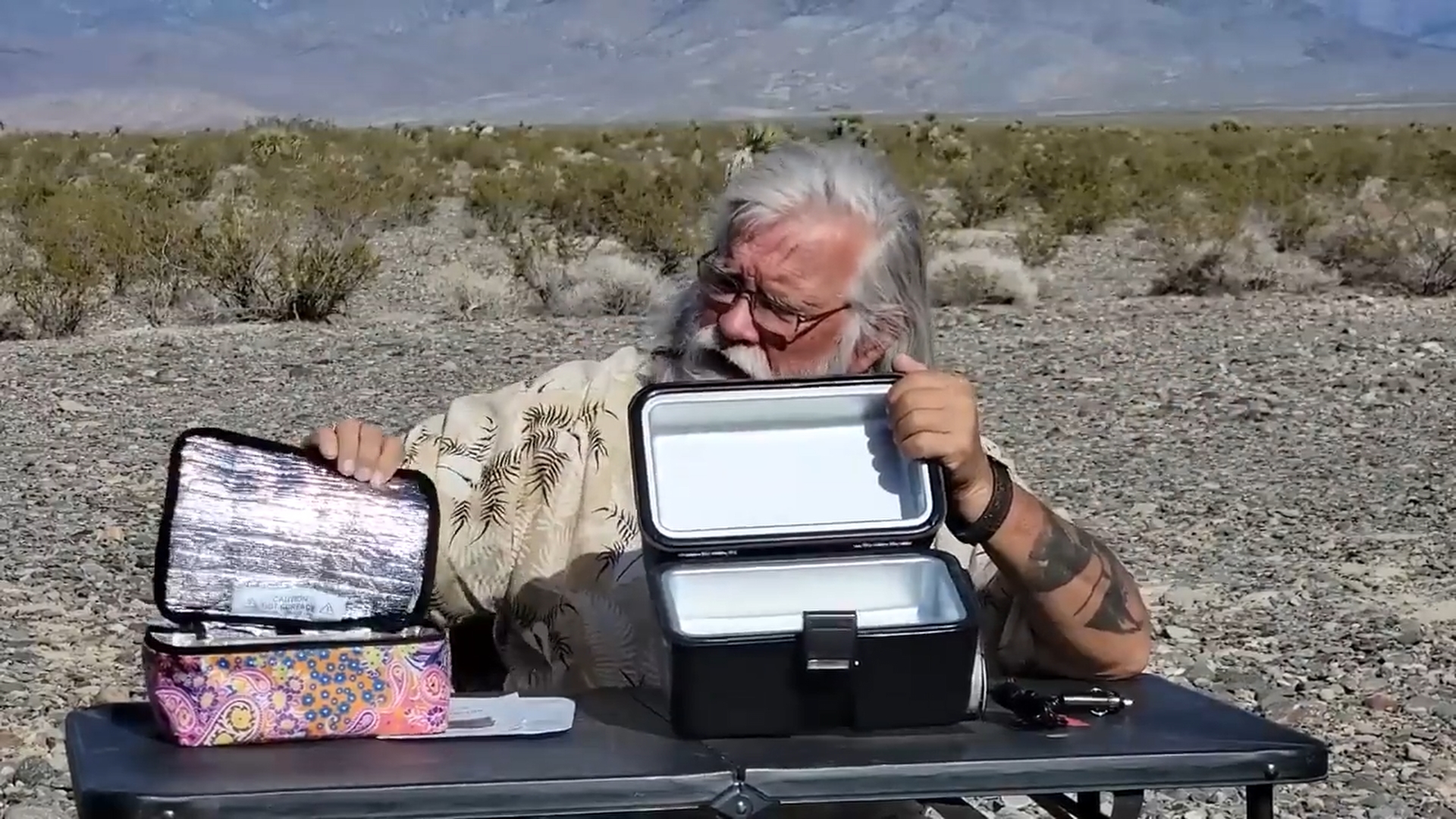
We will do a direct comparison test with the RoadPro against the HotLogic. I personally am such a fan of the RoadPro, and I think it will win. My experience with it has been very, very positive over the years. I’ve been calling it a lunchbox oven, and you’ll see why. What could look more like a lunch box than this thing?
When you open it up, it’s like a complete oven. It’s nearly an inch thick. If this is an inch thick of insulation, it will do a much better job than the HotLogic.
Inside the HotLogic is basically just reflectix, which is not adequate.
How I’ve used the RoadPro before.
If I know I’ll be driving two, four, six, eight hours, I’ll go to the store the night before. I’ll buy some frozen meals and let them thaw in my fridge overnight so they’re ready to go the next day. So maybe I’ll buy a little lasagna, let it thaw, and then line this with heavy-duty aluminum foil so I don’t have to clean it later. Say it’s 11:30 am, and I’m about to stop for lunch. I’ll get the lasagna out of my fridge, put it in here, close it up, seal it, and plug it in. I’ll keep my eye on it while it sits in the front seat beside me. In half an hour, I’ll look, and it’s usually plenty warm. It may not be boiling or bubbling, but it’s plenty warm to eat comfortably. So that took absolutely no effort. I bought it the night before, let it thaw, threw it in here, and I’ve got a hot lunch I enjoy.
Something else I’ve done a lot is chili dogs. I’ll throw a can of chili and one or two hot dogs in there for a great hot meal in forty-five minutes or so.
Will it cook?
I have known people who have done actual cooking in here. You can get a couple of fillet chicken breasts, and it will cook them. It won’t do it in thirty or forty-five minutes like it will to heat up leftovers. It’s not really hot. This might go up to 300 degrees. We’ll test it with the thermometer and see how quickly it works.
We will do our first test of the RoadPro and compare it to the HotLogic. I already know from the person who owns the HotLogic that it will fail, but we’ll go through the motions of it anyway. We’ll cook up chicken breast tenders. I’ve cooked a lot in a RoadPro but never did this. It’ll probably take an hour or two or more, so I’m giving it a lot of time. This is midday, and I’m planning on having it for dinner.
RoadPro Test
Let me show you how I’ve set up the RoadPro. I believe the RoadPro only cooks right on the bottom surface. It may heat on the sides, too, I don’t know. I took some aluminum foil and rolled up pieces like a cigarette. My problem in the past with baking and cooking has been that the bottom gets too hot, and the top is not quite done. I hope the heat will rise and move around by putting this down. I’m just using a standard Walmart mini loaf pan. I’m using chicken breast tenders that won’t be as thick as the whole breast. I think it would be very hard to cook an entire breast in one of these and get the inside done without the outside overdone.
I’m going to run the RoadPro off of the Bluetti EB70. The reason I’m doing that is so I can have a record of what’s going on. The battery is 100%. I fully charged it last night, so I would have a good test.



HotLogic Test
With the HotLogic, I’m doing the same thing. I’ve got the pan sitting on top of the hot plate. It’s going to circulate a lot better. You can see these are much thinner than chicken breasts. The tenders are breasts cut into smaller, more manageable pieces. I’ll put three of them in the HotLogic. I don’t expect them to cook, but I’ll get them started. Of course, seasoning is 100% a personal thing. I like Lawry’s Seasoned Salt and onion powder, but you’ll do whatever you want with them. Then you’ll just close it up. The RoadPro has a nice solid latch. I’ve always found that you hear a nice snap when closing it, giving it a good seal. The HotLogic only has a zipper. I don’t think it puts out as much heat. I don’t think this does nearly as well.


Running on batteries.
I’m going to run the RoadPro off of the Bluetti EB70. The reason I’m doing that is so I can have a record of what’s going on. The battery is 100%. I fully charged it last night, so I would have a good test.
It’s putting out about 110 watts, just shy of 10 amps. So everything here is what I would expect. The RoadPro is sitting in the front seat of my cab, and I’m keeping a record of time. The RoadPro started at 12:12 pm and the HotLogic at 12:09 pm. The HotLogic is inside the ambulance, sitting on some fabric, and plugged into the ambulance system.


1 Hour Later
It has been a full hour, and I will look at the HotLogic and see what’s going on. It’s about 135 degrees on the skin. It’s nowhere near cooked inside. I’ve got to tell you I’m pretty happy it’s up to 135 degrees. Maybe this will do a lot better than I thought.
Next is the RoadPro. The external temperature looks almost identical to the HotLogic at 129 degrees. It’s putting out 114 watts, still about 10 amps, which is what I expect.
2 Hours Later
Now it’s 2:15 pm, and we will try this again. Inside the HotLogic, it is 143 degrees, which is pretty good. I’m impressed. I will turn them over now, too.
The RoadPro was 155 degrees when I opened it. I’m also sticking a meat thermometer in because it’s close to being done. So far, it’s 10 degrees hotter in the RoadPro than in the HotLogic.
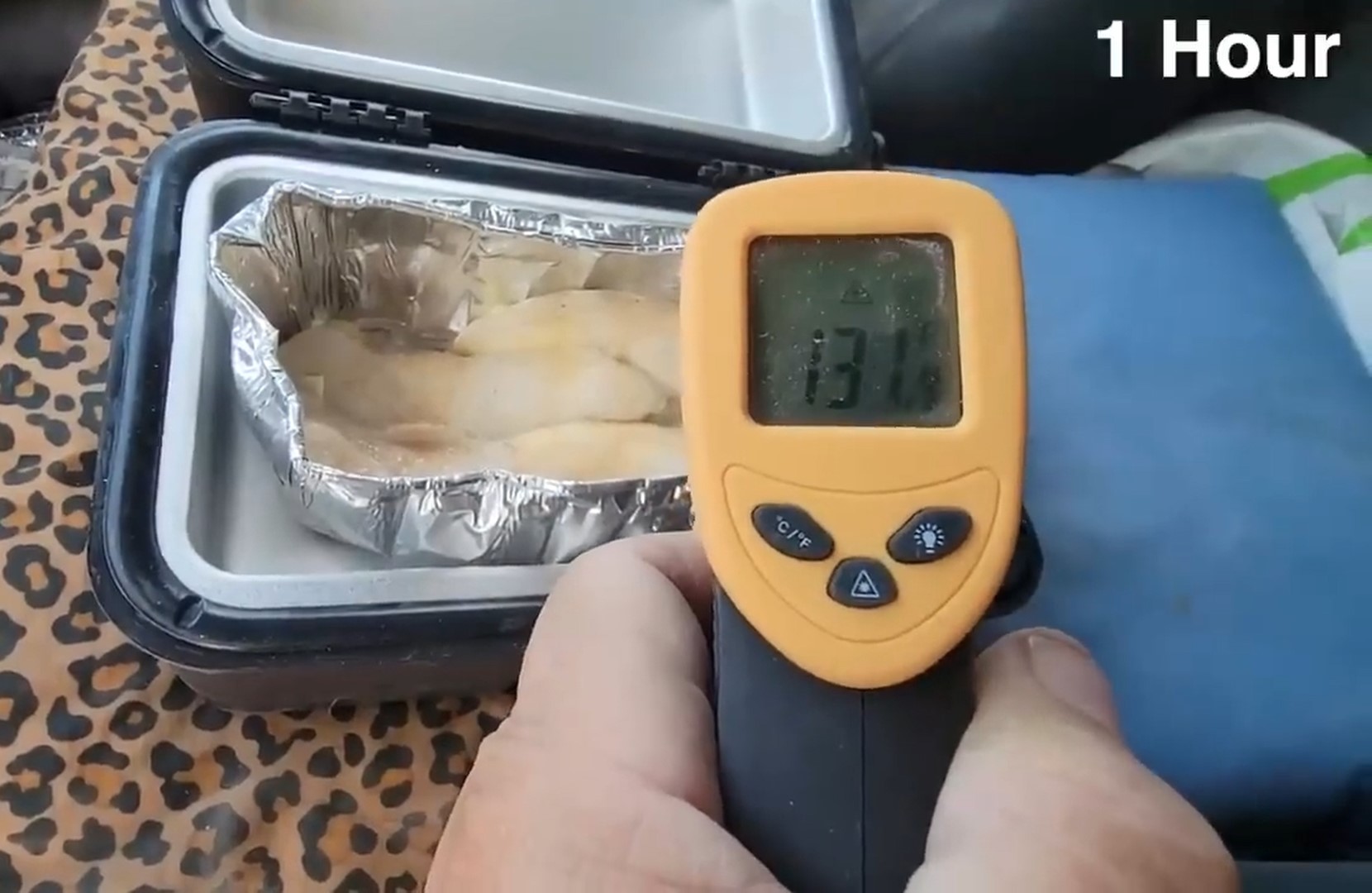
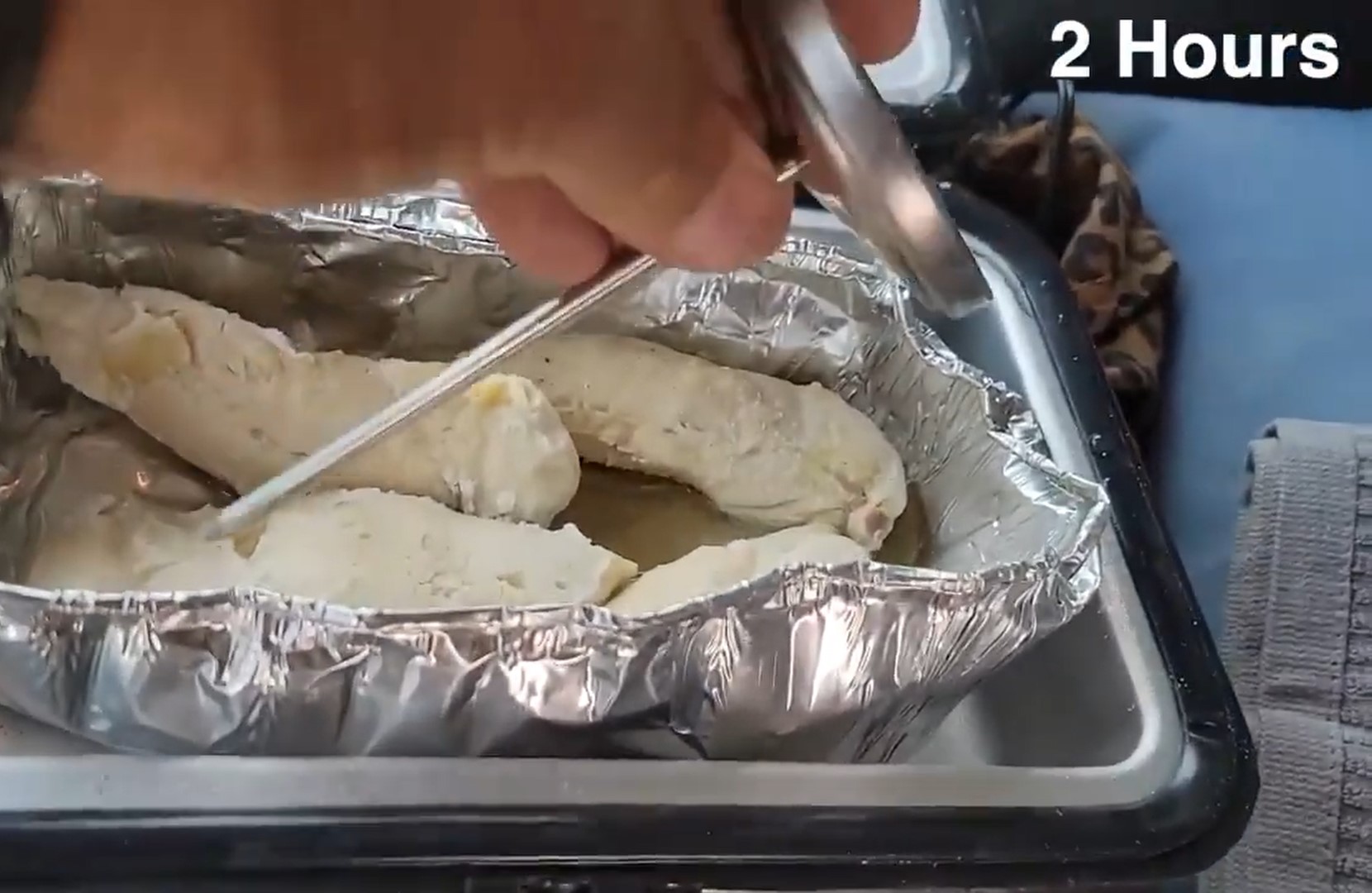
3 Hours Later
It has been three hours, and we’re doing another check on the RoadPro. It is pretty good and warm in there, with a lot of steam coming out. Inside, the box reads 170 degrees with the temperature gun, and the meat thermometer says almost 180 degrees. It’s perfectly done in three hours. I’m very, very happy with that. It worked really, really well.
The battery checks in at sixty percent, so we’ve used forty percent of that battery to cook this in a little over three hours.
4 Hours Later
The HotLogic kept going, so it’s been on for close to four hours, and it’s done. It’s completely done, no problem at all. I’m very, very happy with it too.
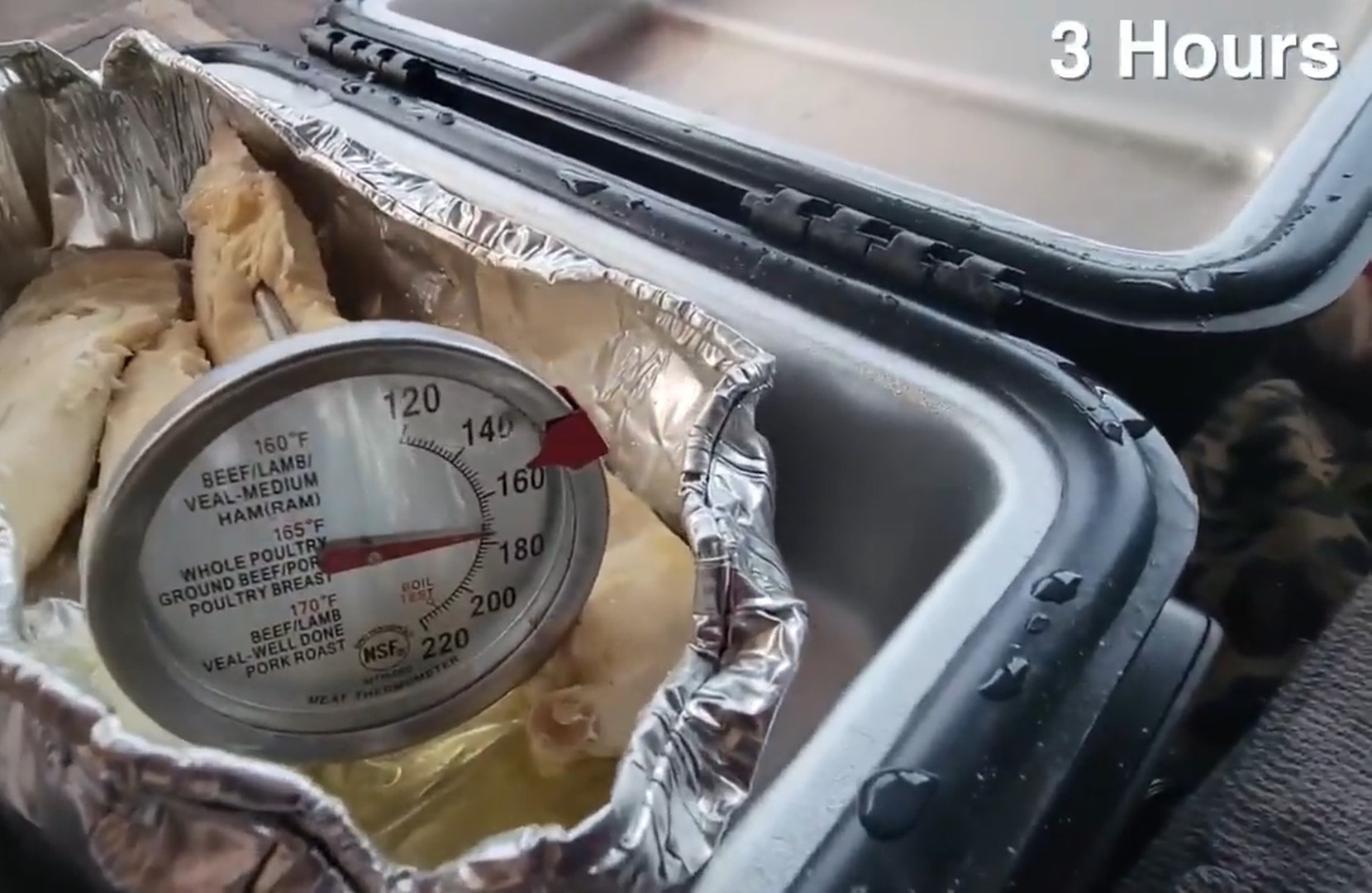
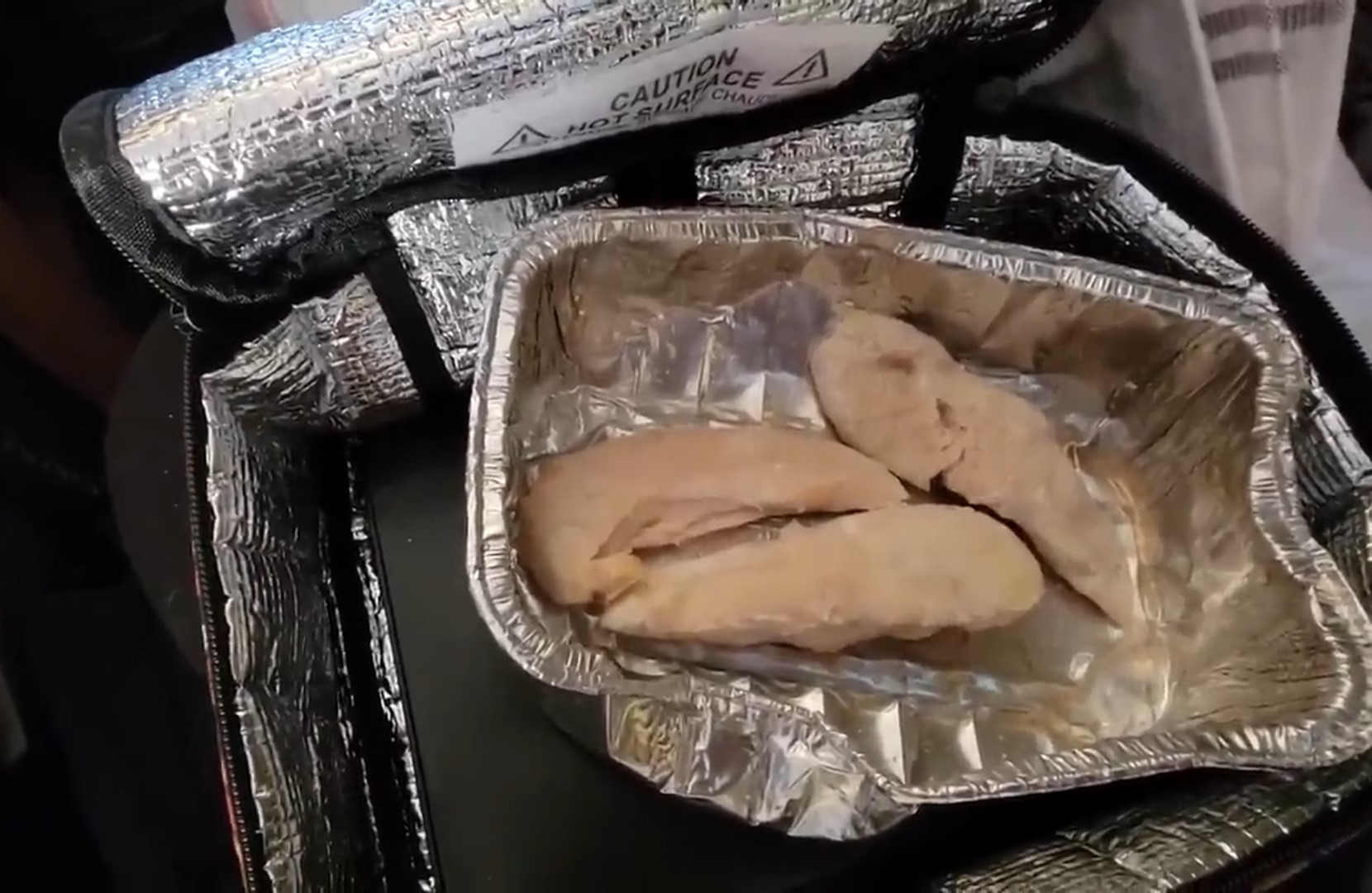
Conclusion
There you have it. The initial test of the HotLogic and the RoadPro. I was really surprised that the HotLogic did as well as it did. It didn’t cook as fast or as well, but it did cook. It took three hours for the RoadPro and about three hours and forty-five minutes for the They were great. The chicken tenders in the RoadPro were better in every way.
I definitely like the RoadPro better at this moment. My friend still says it does poorly on everyday warming, but we’ll have her do some actual testing and get back to you on that. However, I haven’t changed my opinion that RoadPro is superior. I think if I had bundled it up and really insulated it, it would have cut down the time dramatically.
I used the Bluetti, and according to it, it used about 280 watts or about 22 amps to cook the tenders in three hours. So that’s a lot. You’re going to need a pretty substantial system to be able to give up 20 amps to just one meal. You’re okay if you have 300 watts and 200 amp-hour batteries. You can definitely use this for that purpose.
Again, most of the time, you’re just warming things. You’re not actually cooking meat. Cooking meat is going to take the longest of anything you’ll do. If you’re warming something, it’s forty-five minutes, and the draw on forty-five minutes of warming up a can of chili or soup or a thawed frozen lasagna meal is nothing. You’re probably doing that long of a drive, and you plug it into your car and have no draw whatsoever. I think most of us take a three-hour drive, which means you can cook your tenders while driving. It doesn’t cost you any solar because you’re plugged in the whole time.
I hope that helped you get an idea of how you can cook with electricity without needing fossil fuels. You’ll need a reasonably substantial solar system, but 300 watts should be more than enough to run either of these, even to cook meat.

My daughter makes meatloaf, wearing kitchen gloves to keep her hands clean, then cooks it in her RoadPro plugged into her truck while driving. I don’t know how long it takes, though.
We have used the road pro to heat precooked food for a few years. If it is plugged into twelve volt and you are driving it will heat food right from the frig in 20 minutes. We have used it for biscuits and gravy, eggs and sausage, lasagna, chinese, indian, thai, hotdogs – any cooked frozen, canned or takeout food. We always used the aluminum pans so we can just throw them away with no cleaning.